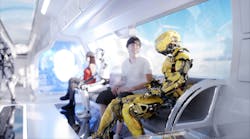What you’ll learn:
- Fear of robots is driven more by science fiction than science fact.
- Robots have already taken on some dirty, dangerous jobs, keeping humans safer.
The idea that humans will build sophisticated robots that eventually gain sentience and decide to use their superior strength and intelligence to threaten and/or subjugate the human race forms the basis of many science-fiction thrillers. The Terminator and Nova depict the possibility of a dystopian future in incredibly entertaining ways, but those concepts combined with recent advances in technology and automation have given rise to fear of robots that’s based more on science fiction than science fact.
A second concern about the alleged “rise of the robots” is also overblown, i.e., that robots will soon make human workers obsolete. This fear is more grounded in reality than the notion that robots are poised to stamp out humanity, if only because robots have been in the workplace for decades and will take on more roles in the future. But the fear that robots will make humans obsolete on the job anytime soon is also unfounded. In fact, robot coworkers are here to help.
What People Get Wrong About Robots
One of the main misconceptions about autonomous robots today is that the technology is more advanced and used more widely than is actually the case. Only a handful of organizations have the capability to produce sophisticated autonomous robots, and even the most advanced and impressive products are preprogrammed to perform specific functions by people—they don’t make independent decisions as sentient beings.
Boston Dynamics has an amazing lineup of agile robot products, including Spot (see video below), a dog-like quadruped that navigates stairs, leaps over rough terrain, avoids collisions, and withstands rain, dust, and extreme temperatures. Spot is equipped with sophisticated cameras and sensors that allow it to capture data and perform a wide range of inspection activities. According to the maker, it can be programmed to function in several industries, including manufacturing, construction, power and utilities, and research.
But video of the cyber canine’s exploits inspired unease in many, and that concern was magnified recently when a Spot unit was donated to the Los Angeles Police Department, according to a recent Los Angeles Magazine article. As the magazine notes, people are concerned about the weaponization of robots, which is a reasonable worry that must be addressed via policies that restrain human decision-makers from weaponizing robots. The robots aren’t capable of weaponizing themselves, and unfounded fears about them could prevent deployment that would benefit humans in myriad ways.
It's important to keep in mind that even the most capable robots don’t truly function independently. Their intelligence and autonomy rely on data and training provided by humans, and their self-learning features take place within parameters set by humans. That’s true for Spot, and it’s true for OpenAI’s ChatGPT, too, which is another advanced technology unsettling some human observers. ChatGPT can pass the Turing Test, but AI experts agree it’s not sentient.
What People Get Right About Robots
Robots aren’t hurting humanity. In fact, robots have proved their utility in helping humans during the pandemic, disinfecting hospital rooms and using ultraviolet rays to kill germs in public spaces where pathogens can linger, such as airport terminals. An environmental services director at one California hospital deployed robots that could disinfect an operating room in just 12 minutes, doing a more thorough job of cleaning floors, ceilings, baseboards, and other surfaces than a human.
Rescue robots and drones are also helping first responder teams find accident victims and natural disaster survivors. Equipped with cameras and sensors, rescue robots can enter areas that may be unsafe for human rescuers, helping teams determine the location of survivors and assess the condition of structures where people are trapped. Rescue robots have proved their utility in the aftermath of events like the devastating earthquakes in Turkey and Syria.
Of course, in addition to these recent examples of humans deploying advanced robots to help people, robotic arms have been used for many years or even decades to lift heavy objects and perform repetitive motions like picking, sorting, and packaging. Drones and robotic equipment have long been tasked with entering dangerous environments like pipelines or blast furnace sites. Robots doing these dirty, dangerous jobs help companies run more efficiently while keeping their human coworkers safer.
The current labor shortage refutes exaggerated fears that robots will soon make workers obsolete. Robots can assist humans in performing many tasks. The fact is, though, that even the most capable robots don’t truly function independently, they aren’t advanced enough to take over, and they won’t be any time soon. They’re here to help humans and not to replace them.
Robots aren’t a realistic threat today, but whether they become so eventually depends on the policy choices humans make in the future.
